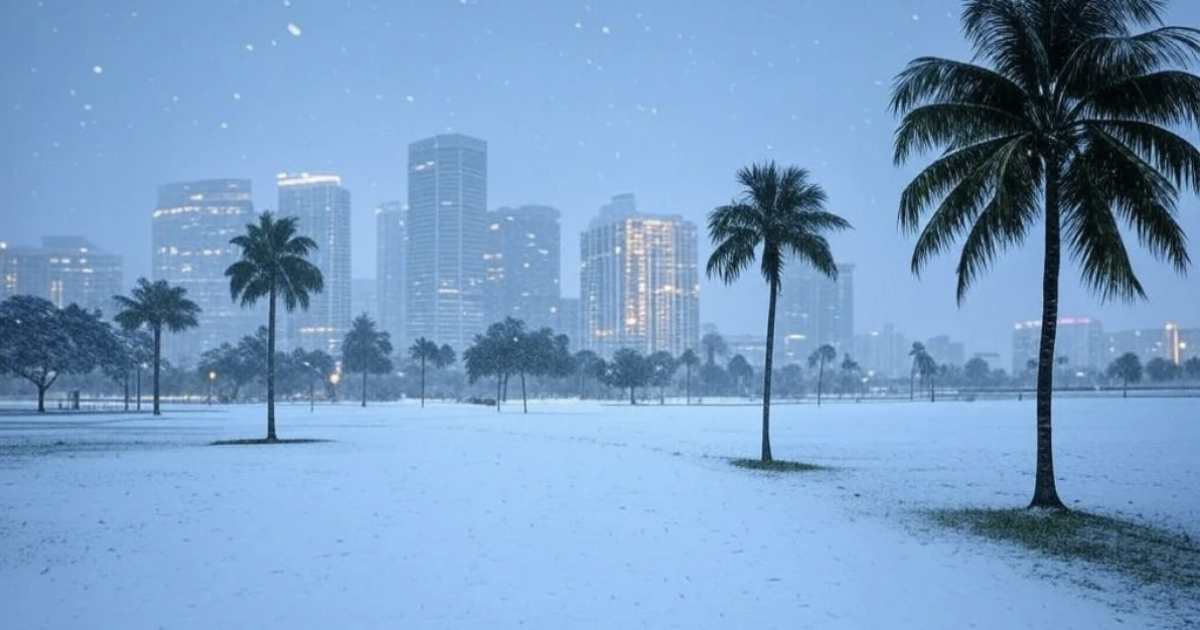
When most people think of Florida, they imagine sunny skies, beautiful beaches, and warm temperatures year-round. Snow isn’t typically associated with this tropical state, but occasionally, Florida does experience the rare phenomenon of snow.
Whether it’s a light dusting or a more significant snowfall, Florida snow is an unusual event that captures the fascination of residents and tourists alike. In this article, we’ll explore the history of Florida snow, the science behind it, and some frequently asked questions regarding snow in the Sunshine State.
The History of Snow in Florida
Snowfall in Florida is extremely rare due to the state’s warm climate, but it has occurred a few times in recorded history. The last significant snow event in Florida was on January 19, 1977, when snow flurries were observed in areas like Tallahassee, Jacksonville, and even parts of Central Florida. It was the first time in more than 30 years that snow had fallen in the state, and it caused a flurry of excitement among residents.
Before 1977, Florida experienced a small amount of snow on rare occasions, with the first recorded snowfall taking place in 1774. However, these events were sporadic and usually limited to the northernmost parts of the state, like the panhandle.
The Science Behind Florida Snow

While Florida is known for its subtropical climate, snow is technically possible in certain parts of the state due to its geography. To understand why snow can occasionally fall in Florida, we need to take a closer look at the conditions required for snow to form.
Temperature and Atmospheric Conditions
For snow to form, the temperature in the clouds must be below freezing (32°F or 0°C). Additionally, the surrounding air must be cold enough for the snowflakes to reach the ground without melting. This is the primary reason why snow is a rare occurrence in Florida, as the average winter temperatures in most areas of the state are usually above freezing.
However, during cold fronts, which are more common in the winter months, temperatures can drop low enough for snow to form. This typically happens in the northern part of the state where the air is colder, and the temperatures are more likely to fall below freezing.
The Role of Cold Fronts
Cold fronts are the main weather system responsible for bringing the cold air needed for snow. These fronts occur when a mass of cold air moves from the north, pushing out the warmer air over Florida. If the cold front is strong enough and the conditions are just right, snow can form and fall in certain areas of Florida.
Snowfall in Florida Where and When It Happens

While snow is rare in Florida, it’s not impossible. The northern and central parts of Florida are more likely to experience snow than the southern regions, due to their colder temperatures during winter. Some of the most notable places where snow has been observed include:
1. Tallahassee
Tallahassee, located in the northern part of Florida, is one of the few areas that has seen significant snowfall. On January 19, 1977, the city experienced snow flurries that lasted several hours, covering the ground with a light dusting of snow. This event is still remembered by locals as one of the most exciting weather occurrences in the city’s history.
2. Jacksonville
Jacksonville, also located in the northern region of the state, is another place where snow has been recorded. On multiple occasions, the city has seen brief snow flurries or light snowfall during particularly cold winter fronts. While it’s not an annual occurrence, Jacksonville does experience occasional snow events.
3. Orlando
Although it’s further south than Tallahassee or Jacksonville, Orlando has also seen snow in the past, albeit very rarely. The most notable snow event in Orlando occurred in 1977 when snow flurries were reported across the area, making it a memorable winter for residents.
4. Pensacola
Pensacola, located in the Florida Panhandle, has experienced snow on a few occasions, particularly during the coldest winter months. Snowfalls in this region are more likely than in other parts of Florida due to the cooler temperatures brought by Arctic air masses.
When Does Snow Fall in Florida?

If snow does fall in Florida, it usually happens during the winter months of December, January, and February. However, snow is more likely to occur during periods of extreme cold, typically associated with strong cold fronts. For instance, the 1977 snowstorm was a result of a particularly powerful cold front that swept through the region.
It’s important to note that even during these cold spells, the snowfall is often light and may not accumulate much on the ground. Snow in Florida tends to be fleeting, melting quickly due to the warmer ground temperatures.
Frequently Asked Questions (FAQs)
1. Does Florida ever get snow?
Yes, Florida can experience snow on rare occasions, particularly in its northern regions. While snowfall is not common, it has been recorded several times in the past, especially during cold fronts.
2. What is the most recent snowfall in Florida?
The most significant snowfall in recent history occurred on January 19, 1977, when snow flurries were observed in cities like Tallahassee, Jacksonville, and Orlando. Since then, Florida has seen a few light snow events but no major snowstorms.
3. Can it snow in Miami?
It is extremely unlikely to see snow in Miami due to its tropical climate. Miami’s average winter temperatures are too warm for snow to form, and snow typically only occurs in the northern and central parts of the state.
4. Why does Florida rarely get snow?
Florida’s generally warm climate, especially in the southern regions, makes it difficult for snow to form. Snow requires temperatures below freezing, which are not common in most parts of Florida. Snow is more likely to occur in the northernmost areas of the state, especially during particularly cold fronts.
5. What do Floridians do when it snows?
When it does snow in Florida, it’s often a cause for celebration and excitement. People may go outside to enjoy the snow, build snowmen, or take pictures. Since snow is such a rare occurrence, it’s usually met with a sense of wonder and awe.
Conclusion
While snow in Florida is a rare and fleeting occurrence, it remains one of the most fascinating and unusual weather phenomena in the state. The combination of Florida’s warm climate and the occasional presence of cold fronts creates the perfect recipe for brief snow events, especially in the northern and central parts of the state. Though snow is not a regular part of Florida’s winter season, when it does fall, it captures the imagination of residents and visitors alike, leaving them with a unique and memorable experience.
For most Floridians, the idea of snow is still a novelty, and even a light dusting brings joy and excitement to the state’s residents. As climate patterns shift and cold fronts continue to move through the region, Florida snow may remain a rare but enchanting occurrence for years to come.







